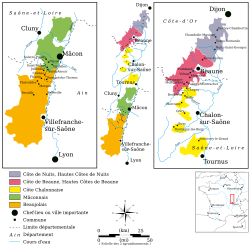
Back برغندي Arabic Vinyes de la Borgonya Catalan Burgundské víno Czech Бургунди (эрех тăвакан ен) CV Burgund (Weinbaugebiet) German Regiono de la Burgonja vino Esperanto Viñedo de Borgoña Spanish Vignoble de Bourgogne French אזור היין של בורגון HE Burgundijska vina Croatian
| Wine region | |
 | |
| Official name | Bourgogne |
|---|---|
| Type | Wine region |
| Year established | AOC in 1936 |
| Country | France |
| Sub-regions |
|
| Climate region | Zone C I |
| Soil conditions | Argilo-limestone |
| Size of planted vineyards | 29,500 hectares 25,000 classified as AOC vineyards |
| No. of vineyards | 100 AOCs |
| Grapes produced | 59.5% of white varieties, 33.8% of red varieties and 6.7% of crémant |
| Varietals produced | Pinot noir, Gamay, Chardonnay, Aligoté |
| Official designation(s) | Regional, village, 1er cru and Grand cru |
| Comments | |
| Official name | Les climats du vignoble de Bourgogne |
| Location | Yonne, Saône-et-Loire, Côte d'Or, France |
| Part of | The Climats, terroirs of Burgundy |
| Criteria | Cultural: (iii)(v) |
| Reference | 1425-001 |
| Inscription | 2015 (39th Session) |
| Area | 13,118 ha (50.65 sq mi) |
| Buffer zone | 50,011 ha (193.09 sq mi) |
| Coordinates | 47°3′29″N 4°51′52″E / 47.05806°N 4.86444°E |
Burgundy wine (French: Bourgogne or vin de Bourgogne) is made in the Burgundy region of eastern France,[1] in the valleys and slopes west of the Saône, a tributary of the Rhône. The most famous wines produced here, and those commonly referred to as "Burgundies", are dry red wines made from pinot noir grapes and white wines made from chardonnay grapes.
Red and white wines are also made from other grape varieties, such as gamay and aligoté, respectively. Small amounts of rosé and sparkling wines are also produced in the region. Chardonnay-dominated Chablis and gamay-dominated Beaujolais are recognised as part of the Burgundy wine region, but wines from those subregions are usually referred to by their own names rather than as "Burgundy wines".
Burgundy has a higher number of appellations d'origine contrôlée (AOCs) than any other French region, and is often seen as the most terroir-conscious of the French wine regions. The various Burgundy AOCs are classified from carefully delineated grand cru vineyards down to more non-specific regional appellations. The practice of delineating vineyards by their terroir in Burgundy goes back to medieval times, when various monasteries played a key role in developing the Burgundy wine industry. The historical importance of the Burgundy wine region and its unique climats system led to sites in the region being inscribed on the UNESCO World Heritage List as part of the Climats, terroirs of Burgundy site.[2]
- ^ Jancis Robinson, ed. (2006). "Burgundy". Oxford Companion to Wine (Third ed.). Oxford: Oxford University Press. pp. 112–116. ISBN 0-19-860990-6.
- ^ "The Climats, terroirs of Burgundy". UNESCO World Heritage Centre. United Nations Educational, Scientific, and Cultural Organization. Retrieved 15 January 2022.
